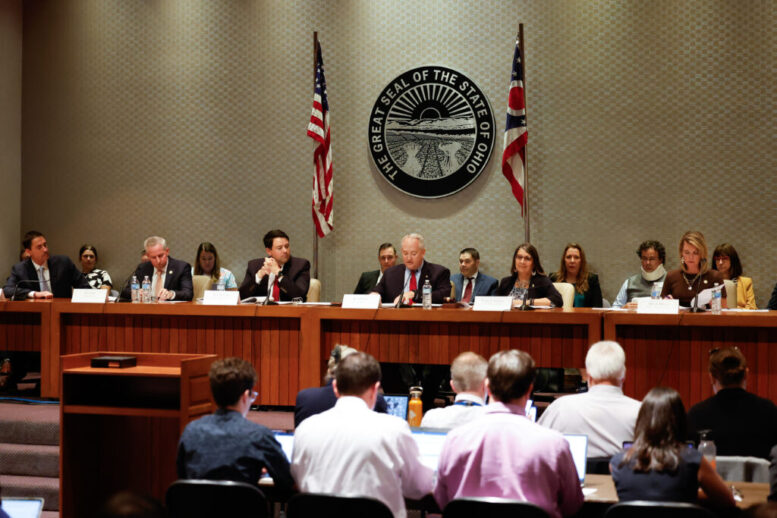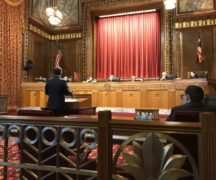BY SUSAN TEBBEN
Some of the leaders of a campaign to reform redistricting in Ohio say the process of drawing districts may be complicated, but making necessary changes to end gerrymandering isn’t: “Political insiders have no business being in the process.”
In a Monday panel discussion on Ohio State University’s campus, retired Ohio Supreme Court Chief Justice Maureen O’Connor, League of Women Voters of Ohio Director Jen Miller, political science professor Ange-Marie Hancock, law professor Steven Huefner, and the Brennan Center Democracy Program’s Yurij Rudensky discussed the impact of gerrymandering on political power, and why a third try at redistricting reform needs to be on the public’s radar if it hits the ballots in November.
The panel members urged support for an initiative created by the coalition Citizens Not Politicians, in conjunction with O’Connor and what she calls “a group of brainiacs,” who developed the proposed ballot measure to undo the “failings” of voter-approved reforms made in 2015 and 2018 through separate constitutional amendments.
“These two amendments were sold as the greatest thing since chocolate milk and sliced bread,” O’Connor said. “I mean, they just thought this was going to be the answer. It was not.”
The drafters had perhaps known the amendments would not go as far as voters hoped, O’Connor posited.
“As a result, there’s language in (the previous amendments) that limits the power of the people and enhances the power of the legislature,” according to the retired chief justice.

Rudensky went so far as to argue that the 2015 and 2018 measures weren’t reforms at all because the measures “didn’t change anything.”
“The reality is what those amendments demonstrated is that political insiders have no business being in the process,” Rudensky said. “As soon as they got the pen after those amendments, what they said are the safeguards are just there as aspirations.”
In the last two years, the redistricting process was overseen by the Ohio Redistricting Commission, a group fully made up of elected officials, the majority of which were members of the GOP. Bipartisan co-chairs led the efforts, along with Republican Gov. Mike DeWine, Republican Auditor of State Keith Faber, Republican Secretary of State Frank LaRose, and Republican state Sen. Rob McColley in the most recent round of commission meetings. The two Democratic seats that completed the commission were most recently filled by House Minority Leader Allison Russo and Senate Minority Leader Nickie Antonio.
This version of the commission was the only version to adopt a district map with bipartisan agreement, something that helped the Statehouse district map, adopted in September 2023, when it was challenged in the Ohio Supreme Court. Justices cited the agreement as a key reason the majority ruled to leave the map in place, despite arguments that the newest ORC map is unduly partisan.
The five other versions of maps adopted by the commission were struck down by the court due to unconstitutional partisan lean. The makeup of the court was different than the court that oversaw the challenge of the September map in one important area: then-Chief Justice Maureen O’Connor served as the swing vote that resulted in the rejection of those five Statehouse maps, and for that matter, the only two U.S. congressional district maps ever drawn.
The congressional map that is currently being used is still one ruled unconstitutional by the O’Connor-led state supreme court.
“The resulting maps clearly opened the door so that a supermajority will be established, and once that happens, unless there’s a change, such as the constitutional amendment that’s going to be on in November, this is self-perpetuating,” O’Connor said in the Monday panel. “This will go on and on and on.”
The new measure would depart from previous redistricting reforms, the supporters said on Monday, by bringing about an independent commission to redraw the district maps, a commission that would be chosen through a vetting process done by judges and bipartisan members of a screening committee.
This main goal of the new constitutional amendment – which is still in the signature-collection stage before it can be approved to appear on the November general election ballot – would take the map-drawing process for Statehouse and congressional districts out of the hands of elected officials, something those on the panel said has been the downfall of the previous reforms.
But with the previous reforms not far off in Ohio’s history, panelist addressed concerns that voter exhaustion over the redistricting issue could come into play and cause Ohioans to wonder why yet another redistricting reform would matter.
“The biggest thing I get as a concern is once again the court would not have the power, or concern that there would still be loopholes,” Miller said. “I’m proud to say that a lot of brilliant folks designed this policy to make sure that we have lots of guardrails, so that we can truly end gerrymandering.”
The implementation of a new constitutional amendment on redistricting wouldn’t necessarily flip the political makeup of the state on its head, and it may not even change the majorities in the state, but it would bring Ohio’s partisanship down to levels that match voting trends, O’Connor argued.
“There will be, in all probability, more Republicans members of the Ohio General Assembly than Democrats when this is done, but it won’t be a supermajority,” according to O’Connor, a registered Republican herself.
Without the “wildly inflated numbers” in the majority, O’Connor said the impact will be widely seen, bringing more difficulty in overriding a governor’s vetoes, for example, and creating an legislative environment that will “force the representatives to work with one another.”
“There will be products that are not extreme,” she said. “In other words, their legislation will be tempered by the fact that there’s a new mindset: we’ve got to work together and we need to work for the citizens; not lobbyists, not the people who funded our campaigns, not political bosses in Columbus or in my local county.”
Despite their hope for change through the proposed amendments, the panelists didn’t mince words about the work still to be done even if the reforms are approved by voters.
“Yes, there are changes that would come about as part of this, but there’s also … a lot of oversight and implementation that would have to take place afterward as well,” Hancock said.
That would include making sure redistricting meetings are public and the work is done before the eyes of Ohioans.
“Voters want to know that folks are not taking advantage, that folks are doing what they’re supposed to do, what their oath of office demands,” Hancock said.





